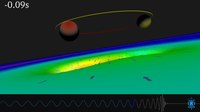
Photo from wikipedia
We studied “strongly enhanced” excitations of magnetostatic spin-waves in a hybrid magnon-photon-coupled system consisting of an inverted split-ring resonator and an yttrium iron garnet film. The backward-volume magnetostatic wave, magnetostatic… Click to show full abstract
We studied “strongly enhanced” excitations of magnetostatic spin-waves in a hybrid magnon-photon-coupled system consisting of an inverted split-ring resonator and an yttrium iron garnet film. The backward-volume magnetostatic wave, magnetostatic surface wave, forward-volume magnetostatic wave modes, as well as multiple mixed modes were observed according to the direction of externally applied magnetic fields with respect to the spin-wave propagation direction. From experimental measurements, we found that there exist certain characteristic angles, which is to say, critical angles (θc, ϕc), whereby the group velocity of the excited spin-wave modes reaches zero, along with a single ferromagnetic resonance peak. Furthermore, we analytically derived the critical angles as sin θ c = ( H eff / H ) { 2 − ( 1 + μ 0 M s / H eff ) si n 2 ϕ c } − 1 / 2 , where Heff is the effective magnetic-field strength, H the externally applied field strength, and μ0Ms is the saturation magnetization. This analytical form is in quantitative agreement with estimations from experimentally observed spin-wave modes. This work not only provides a better understanding of multiple-mode spin-wave excitations in given field directions with the help of photon-magnon coupling, but also offers better coupling controllability based on the change of the external magnetic field direction.We studied “strongly enhanced” excitations of magnetostatic spin-waves in a hybrid magnon-photon-coupled system consisting of an inverted split-ring resonator and an yttrium iron garnet film. The backward-volume magnetostatic wave, magnetostatic surface wave, forward-volume magnetostatic wave modes, as well as multiple mixed modes were observed according to the direction of externally applied magnetic fields with respect to the spin-wave propagation direction. From experimental measurements, we found that there exist certain characteristic angles, which is to say, critical angles (θc, ϕc), whereby the group velocity of the excited spin-wave modes reaches zero, along with a single ferromagnetic resonance peak. Furthermore, we analytically derived the critical angles as sin θ c = ( H eff / H ) { 2 − ( 1 + μ 0 M s / H eff ) si n 2 ϕ c } − 1 / 2 , where Heff is the effective magnetic-field strength, H the externally applied field strength, and μ0Ms is the saturation magnetization. ...
Journal Title: Journal of Applied Physics
Year Published: 2019
Link to full text (if available)
Share on Social Media: Sign Up to like & get
recommendations!